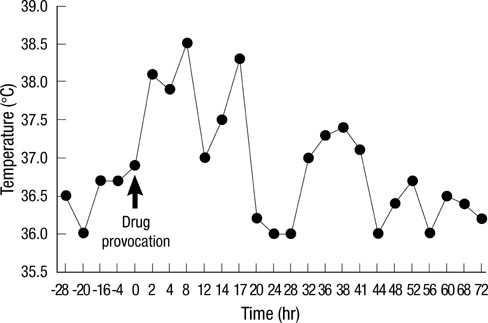J Korean Med Sci.
2011 Feb;26(2):301-303. 10.3346/jkms.2011.26.2.301.
Drug Fever Due to Piperacillin/Tazobactam Loaded into Bone Cement
- Affiliations
-
- 1Division of Allergy, Asthma and Clinical Immunology, Department of Internal Medicine, Research Institute of Medical Sciences, Chonnam National University Medical School, Gwangju, Korea. yikoh@chonnam.ac.kr
- KMID: 1782123
- DOI: http://doi.org/10.3346/jkms.2011.26.2.301
Abstract
- Although drug fever may develop after administration of the drug by various routes, it has not been reported with antibiotic-loaded bone cement. Here, a case of drug fever induced by piperacillin/tazobactam loaded into bone cement is reported. A 72-yr-old woman presented with fever that developed two weeks after insertion of bone cement loaded with antibiotics including piperacillin/tazobactam into the knee joint for infectious arthritis. The fever was associated with a skin rash and blood eosinophilia. The work-up of the fever excluded several causes. Drug provocation test demonstrated that the piperacillin/tazobactam, which had been loaded in the bone cement, was the cause of the fever. The findings of this case suggest that drug fever can be induced by any drug placed and released continuously within the body. Therefore, the evaluation for possible drug fever should include all drugs the patient has been exposed to regardless of the route of administration.
Keyword
MeSH Terms
-
Aged
Anti-Bacterial Agents/*adverse effects
Arthritis/drug therapy/pathology/surgery
Bone Cements/*adverse effects/*chemistry
Drug Therapy, Combination
Enzyme Inhibitors/adverse effects
Female
Fever/*chemically induced
Humans
Penicillanic Acid/adverse effects/*analogs & derivatives
Piperacillin/*adverse effects
Figure
Reference
-
1. Hanson MA. Drug fever. Remember to consider it in diagnosis. Postgrad Med. 1991. 89:167–170.2. Johnson DH, Cunha BA. Drug fever. Infect Dis Clin North Am. 1996. 10:85–91.3. Roush MK, Nelson KM. Understanding drug-induced febrile reactions. Am Pharm. 1993. NS33:39–42.4. Ditto AM. Grammer LC, Greenberger PA, editors. Drug allergy. Patterson's allergic diseases. 2009. 7th ed. Philadelphia: Lippincott Williams & Wilkins;238–75.5. Patel RA, Gallagher JC. Drug fever. Pharmacotherapy. 2010. 30:57–69.6. Henry SL, Galloway KP. Local antibacterial therapy for the management of orthopaedic infections. Pharmacokinetic considerations. Clin Pharmacokinet. 1995. 29:36–45.7. Shi M, Kretlow JD, Nguyen A, Young S, Scott Baggett L, Wong ME, Kasper FK, Mikos AG. Antibiotic-releasing porous polymethylmethacrylate constructs for osseous space maintenance and infection control. Biomaterials. 2010. 31:4146–4156.8. Chohfi M, Langlais F, Fourastier J, Minet J, Thomazeau H, Cormier M. Pharmacokinetics, uses, and limitations of vancomycin-loaded bone cement. Int Orthop. 1998. 22:171–177.9. Kelm J, Regitz T, Schmitt E, Jung W, Anagnostakos K. In vivo and in vitro studies of antibiotic release from and bacterial growth inhibition by antibiotic-impregnated polymethylmethacrylate hip spacers. Antimicrob Agents Chemother. 2006. 50:332–335.
- Full Text Links
- Actions
-
Cited
- CITED
-
- Close
- Share
- Similar articles
-
- In vitro Susceptibility of Imipenem-resistant Pseudomonas aeruginosa against Piperacillin/tazobactam
- Comparison of Cefepime Monotherapy with Piperacillin-Tazobactam, Gentamicin Combination Therapy in Pediatric Cancer Patients with Febrile Neutropenia
- Piperacillin/Tazobactam-Associated Hypersensitivity Syndrome with Overlapping Features of Acute Generalized Exanthematous Pustulosis and Drug-Related Rash with Eosinophilia and Systemic Symptoms Syndrome
- In Vitro Susceptibility of piperacillin/tazobactam Against extended-spectrum beta-lactamase-producing Escherichia coli and Klebsiella pneumoniae
- In-Vitro Efficacy of Synergistic Antibiotic Combinations in Multidrug Resistant Pseudomonas Aeruginosa Strains



